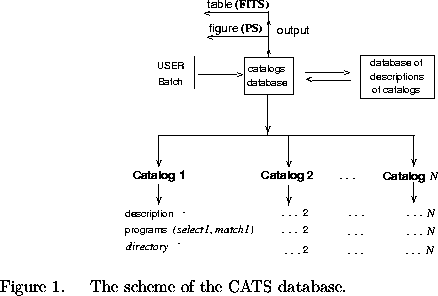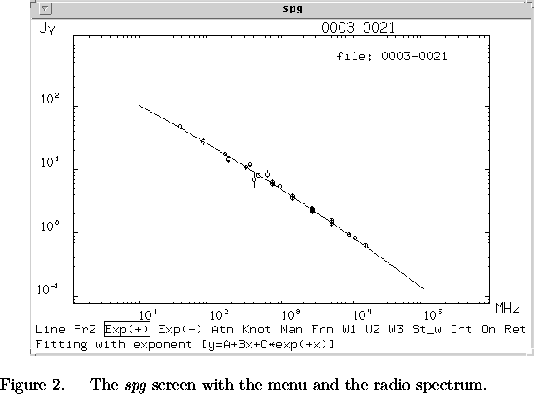
Next: Dynamic Dynamic Queries (DDQ)
Previous: A Database-driven Cache Model for the DADS Optical Disk Archive
Up: Data Archives
Table of Contents - Index - PS reprint - PDF reprint
O. V. Verkhodanov and S. A. Trushkin
Special Astrophysical Observatory, Nizhnij Arkhyz,
Karachaj-Cherkessia, Russia, 357147
H. Andernach
INSA; ESA IUE Observatory, Apdo. 50727, E-28080 Madrid, Spain
V. N. Chernenkov
Special Astrophysical Observatory, Nizhnij Arkhyz,
Russia, 357147
Different attempts have been made to combine many astronomical catalogs in unified databases-NED, SIMBAD, ESIS, ADS, etc.(see reviews by Andernach et al. 1994; Andernach 1995). Important shortcomings of these databases are (a) the incompleteness of the information stored compared to that offered in the original publication and (b) the necessity of copying the whole catalog (if available at all) for dedicated work with it. We propose a new solution to this problem with a ``CATalogs supporting System'' (CATS) at Special Astrophysical Observatory (SAO). It allows a user to operate with catalogs coded in plain ASCII, to cross-identify different radio catalogs, to calculate spectral indices, to construct and fit spectra. This database is now running on the server ratan.sao.ru of SAO of Russian Academy of Sciences (RAS), and constitutes part of the data bank of SAO RAS (Kononov 1995).
The present active database of catalogs, version 1.0 (Figure 1), is a unification of catalogs, descriptions of catalogs, and programs operating on these executing on the freely distributed version of UNIX (Linux) running on a Pentium server (Verkhodanov & Trushkin 1995) at the RATAN-600. The programs are coded in C and are freely sharable except for commercial use.

New catalogs may be added to CATS in conformity with the following rules:
1) every new catalog of objects has to be contained in the UNIX directory having the same name as the catalog of objects; 2) the description of the catalog must also be in that directory; 3) the programs for local operation on the catalog of objects must also be in the same directory; 4) brief characteristics and names of the programs and file with the description of the catalog must be stored in the file cats_descr.
The described manner of catalog storage eases the database development, its expansion with new data, and the fine-tuning of the supporting programs.
Virtually all catalogs have a different format and list different observables. It will be a major challenge to provide uniform access to such a heterogeneous collection of data sets based on different methods, using different notations and units (in the absence of a ``standard'' to create catalogs). Except for parameter-dependent derived quantities, we intend to use all different fields (i.e., the columns of data tables) as they were published.
CATS can accomplish the following tasks:
1) Provide a short description and characteristics of each catalog; print the full list of catalogs relevant for a given sky area. 2) Select objects from one or several catalogs matching user-specified criteria, such as equatorial and galactic coordinates, flux densities and spectral indices, observing frequency, names of catalogs unified in mixed catalogs as Dixon's Master Source List, and object type (if provided by the catalog). 3) Cross-identification of different catalogs and selection after calculation of spectral indices. 4) Drawing radio spectra of selected sources in PostScript.
The result of the object selection can be sent to the standard output or saved in the following formats:
1) The original format of the input catalog. 2) A standard format, common for all catalogs and used further for unification and operation with spectra or other parameters. The standard FITS TABLE header describing the various data fields of the table may be recorded with the resulting file. 3) X-window codes or tape archives (TAR format) of compressed PostScript files for graphical spectra of radio sources.
The result of the CATS operation is an ASCII file sorted according to object characteristics. It can be used for subsequent investigation of the radio source spectra or statistical source properties in the RATAN-600 data processing system (Verkhodanov 1997).
On-line access to CATS will be provided in several modes:
1) Dialog mode (non-graphics) is the only mode established at present. Several UNIX shell scripts (Verkhodanov & Trushkin 1995) permit the execution of the database-supporting programs via TCP/IP and NFS protocols in the local computer net of SAO. 2) Access via TCL/Tk scripts on the basis of shell. This mode also allows operation on the figures or profiles of radio spectra or statistical distributions by different parameters of the selected samples. 3) Hypertext access will eventually allow remote Internet users to operate with CATS via hypertext transfer protocol (HTML). It will allow execution of all described operations in graphic mode and will probably take advantage of the Java language.
Presently we are working on a further type of access to CATS by e-mail request, permitting the user to send a message with his/her requests. The latter will be read automatically and sent for execution to the CATS scripts. The result will be sent automatically to the user via e-mail. Very bulky results will be placed in a public FTP area and the user will be informed about the FTP address of the file(s). The e-mail messages may have several formats describing the search window, the coordinates of the center, the epoch, the type of output format, and the type of catalogs to search. CATS also permits the copying of entire catalogs (via FTP) to the user's local computer and to operate with them ``at home.''

CATS operates with continuum spectra of radio sources recorded as FITS
tables. The graphics program spg (SPectra Graphics) allows a user to fit
a spectrum with a standard set of curves:
1) y = A + Bx,
2)  ,
3)
,
3)  ,
4)
,
4)  ,
where
,
where  ,
,  ,
,  is the frequency (MHz), S is
the flux density (Jy).
is the frequency (MHz), S is
the flux density (Jy).
The menu of the spg program (Figure 2) allows a user to choose among these curves either automatically (by a least-squares fit), or by manual selection of the fitting function, or by manual fitting using the mouse (where the curve follows a cursor). Data points may be weighted in different ways: setting equal weight, setting weights by flux density errors, or filling a form with a table of frequencies, flux densities, and weights.
The development of CATS will provide a simple and convenient access to astrophysical information and accelerate the process of obtaining characteristics of celestial objects. Operation with the database will permit astronomers to search for peculiar objects and study physical processes in sources of cosmic radiation.
CATS allows a user not only to get accurate positions of radio sources to study radio spectra, but also to derive different statistical properties of object samples. Trushkin & Verkhodanov (1995) recently demonstrated such possibilities in a cross-identification of two large catalogs in two different frequency ranges: the IRAS Point Source Catalog in the infrared and the UTRAO survey at 365MHz. Two of us (H. A. and O. V.) are working on the cross-identification and eventual optical identification of UTR survey sources detected at 12-25MHz. We plan to solve the problem of very large error boxes by a stepwise cross-identification progressing from low frequencies and angular resolution to higher ones until the error box size permits the optical identification.
CATS is being expanded continuously. Presently it comprises over 50 catalogs including all the RATAN-600 catalogs and occupies ~250MB. The database system could be an essential part of a bigger project of the first publicly accessible database of radio sources, proposed by Andernach et al. (1997).
This work is supported by the Russian Foundation of Basic Research (grant No 96-07-89075). O. Verkhodanov thanks ISF-LOGOVAZ Foundation for the travel grant, the SOC for the financial aid in the living expenses and the LOC for the hospitality.
Andernach, H., Hanisch, R. J., & Murtagh, F. 1994, PASP, 106, 1190
Andernach, H. 1995, Astroph.Lett.& Comm. 31, 1
Andernach, H., Trushkin, S. A., Gubanov, A. G., Verkhodanov, O. V., Titov, V. B., & Micol, A. 1997, Baltic Astronomy, 6, 259
Kononov, V. K. 1995, Preprint 111T, SAO RAS, 22
Trushkin, S. A., & Verkhodanov, O. V. 1995, Bull. SAO, 39, 150
Verkhodanov, O. V. 1997, this volume
Verkhodanov, O. V. & Trushkin, S. A. 1995, Preprint 106 SAO RAS, 66
Next: Dynamic Dynamic Queries (DDQ)
Previous: A Database-driven Cache Model for the DADS Optical Disk Archive
Up: Data Archives
Table of Contents - Index - PS reprint - PDF reprint